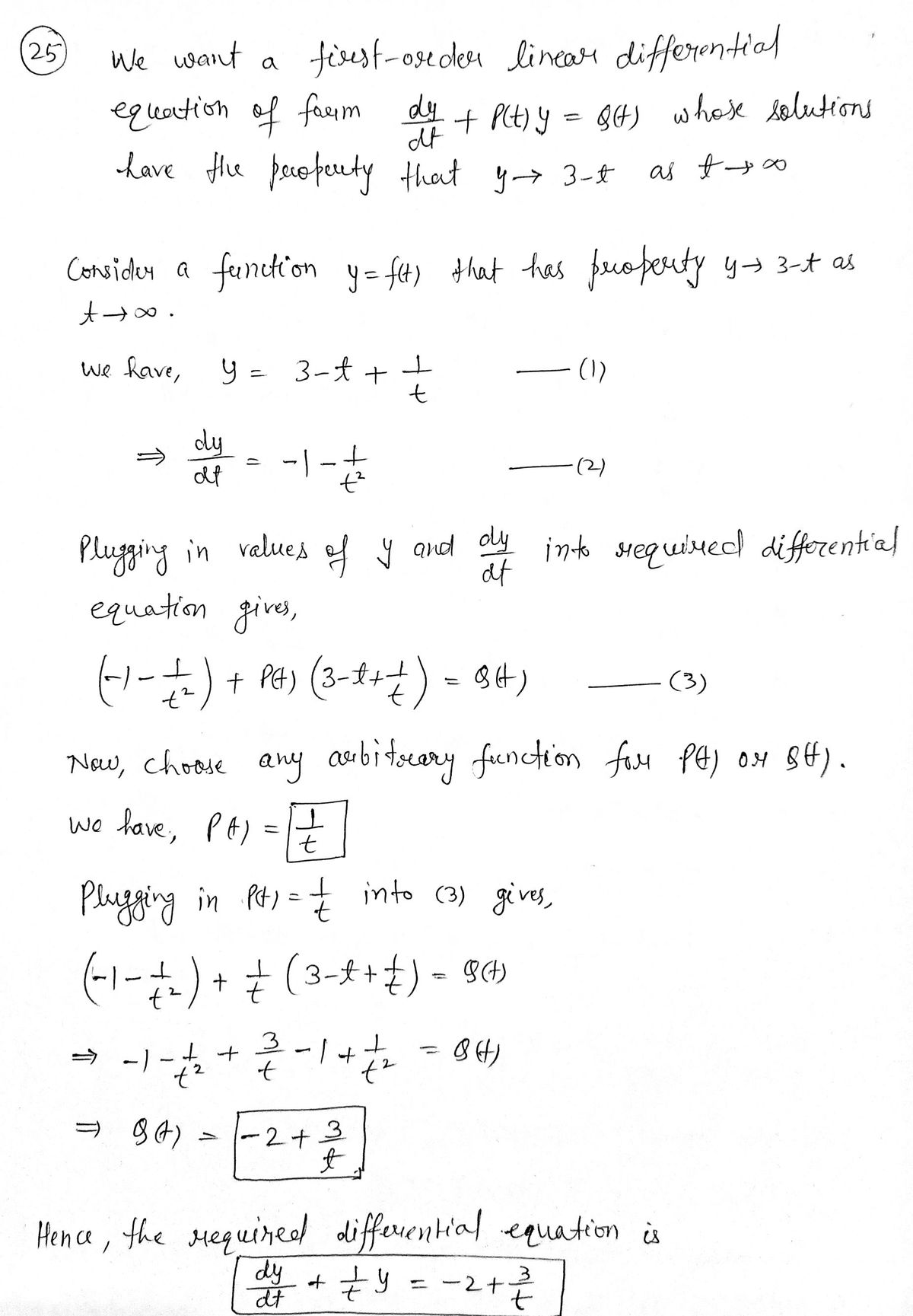In each of Problems 24 through 27, construct a first-order linear differential equation whose solutions have the required behavior as t→∞. Then solve your equation and confirm that the solutions do indeed have the specified property. 24. All solutions have the limit 3 as t→∞. 25. All solutions are asymptotic to the line y = 3-tast → ∞. 26. All solutions are asymptotic to the line y = 2t - 5 as t→ ∞. 27. All solutions approach the curve y = 4-t² as t → ∞.
In each of Problems 24 through 27, construct a first-order linear differential equation whose solutions have the required behavior as t→∞. Then solve your equation and confirm that the solutions do indeed have the specified property. 24. All solutions have the limit 3 as t→∞. 25. All solutions are asymptotic to the line y = 3-tast → ∞. 26. All solutions are asymptotic to the line y = 2t - 5 as t→ ∞. 27. All solutions approach the curve y = 4-t² as t → ∞.
Calculus: Early Transcendentals
8th Edition
ISBN:9781285741550
Author:James Stewart
Publisher:James Stewart
Chapter1: Functions And Models
Section: Chapter Questions
Problem 1RCC: (a) What is a function? What are its domain and range? (b) What is the graph of a function? (c) How...
Related questions
Question
25

Transcribed Image Text:has the property that y→ 0 ast →∞.
λ
Hint: Consider the cases a = A and a separately.
In each of Problems 24 through 27, construct a first-order linear
differential equation whose solutions have the required behavior as
t→∞. Then solve your equation and confirm that the solutions do
indeed have the specified property.
24. All solutions have the limit 3 as t →∞.
25. All solutions are asymptotic to the line y = 3-t as too.
26. All solutions are asymptotic to the line y = 2t - 5 as t→∞0.
27. All solutions approach the curve y = 4-t² as t → ∞.
28. Variation of Parameters. Consider the following method of
solving the general linear equation of first order:
y' + p(t) y = g(t).
a. If g(t) = 0 for all t, show that the solution is
exp(- [p(1) dt).
y = A exp
(1) exp(- / p(1) dt).
where A is a constant.
b. If g(t) is not everywhere zero, assume that the solution of
equation (48) is of the form
y = A(t) exp
dt
(1) exp ( √p(1) dr)
(48)
A'(t) = g(t) exp
(49)
where A is now a function of t. By substituting for y in the given
differential equation, show that A(t) must satisfy the condition
equation (50) and determine
c. Find A(t) from equation (51). Then substitute for
(50)
(51)
Expert Solution
Step 1

Trending now
This is a popular solution!
Step by step
Solved in 2 steps with 2 images

Recommended textbooks for you

Calculus: Early Transcendentals
Calculus
ISBN:
9781285741550
Author:
James Stewart
Publisher:
Cengage Learning

Thomas' Calculus (14th Edition)
Calculus
ISBN:
9780134438986
Author:
Joel R. Hass, Christopher E. Heil, Maurice D. Weir
Publisher:
PEARSON

Calculus: Early Transcendentals (3rd Edition)
Calculus
ISBN:
9780134763644
Author:
William L. Briggs, Lyle Cochran, Bernard Gillett, Eric Schulz
Publisher:
PEARSON

Calculus: Early Transcendentals
Calculus
ISBN:
9781285741550
Author:
James Stewart
Publisher:
Cengage Learning

Thomas' Calculus (14th Edition)
Calculus
ISBN:
9780134438986
Author:
Joel R. Hass, Christopher E. Heil, Maurice D. Weir
Publisher:
PEARSON

Calculus: Early Transcendentals (3rd Edition)
Calculus
ISBN:
9780134763644
Author:
William L. Briggs, Lyle Cochran, Bernard Gillett, Eric Schulz
Publisher:
PEARSON

Calculus: Early Transcendentals
Calculus
ISBN:
9781319050740
Author:
Jon Rogawski, Colin Adams, Robert Franzosa
Publisher:
W. H. Freeman


Calculus: Early Transcendental Functions
Calculus
ISBN:
9781337552516
Author:
Ron Larson, Bruce H. Edwards
Publisher:
Cengage Learning